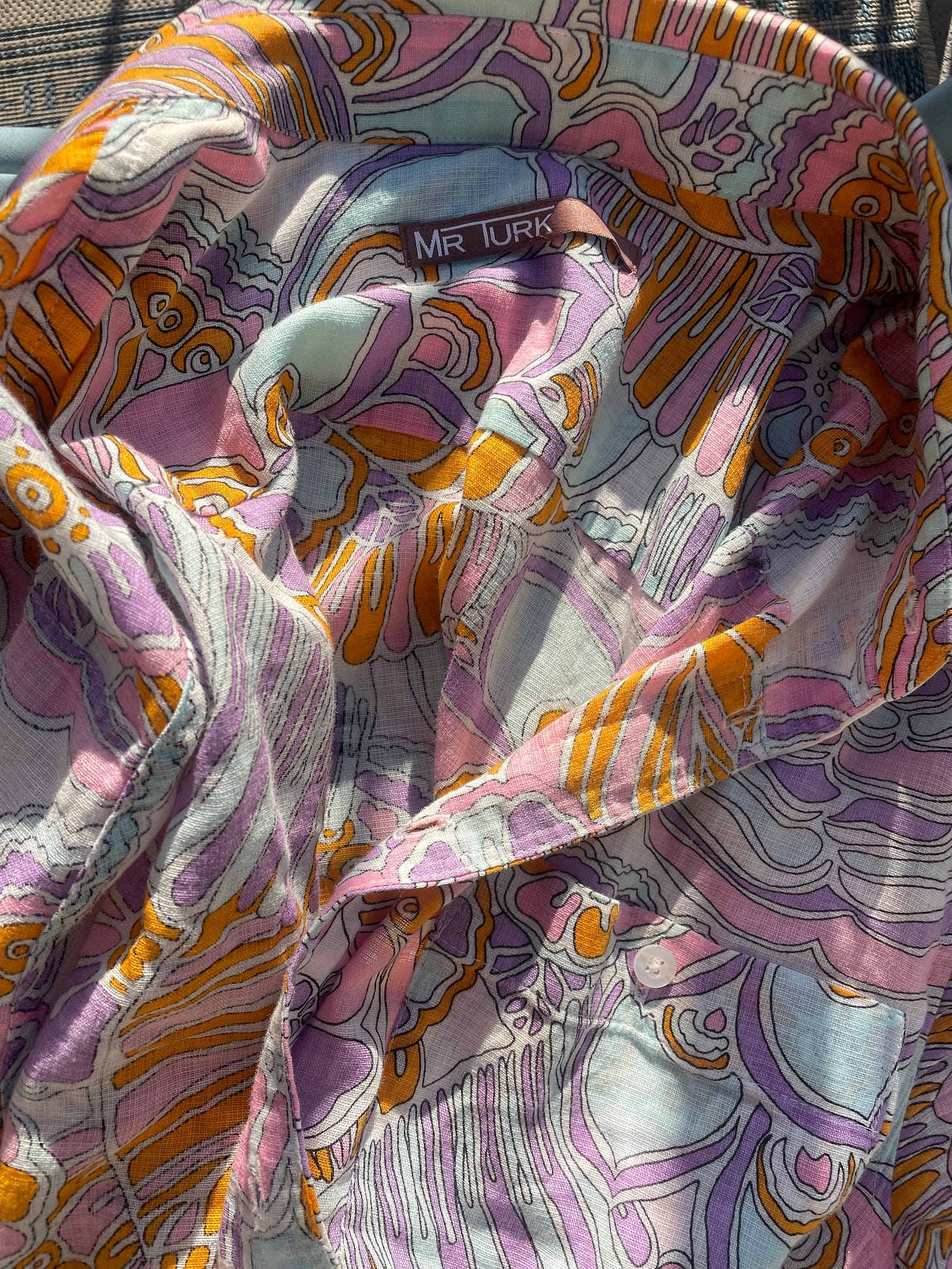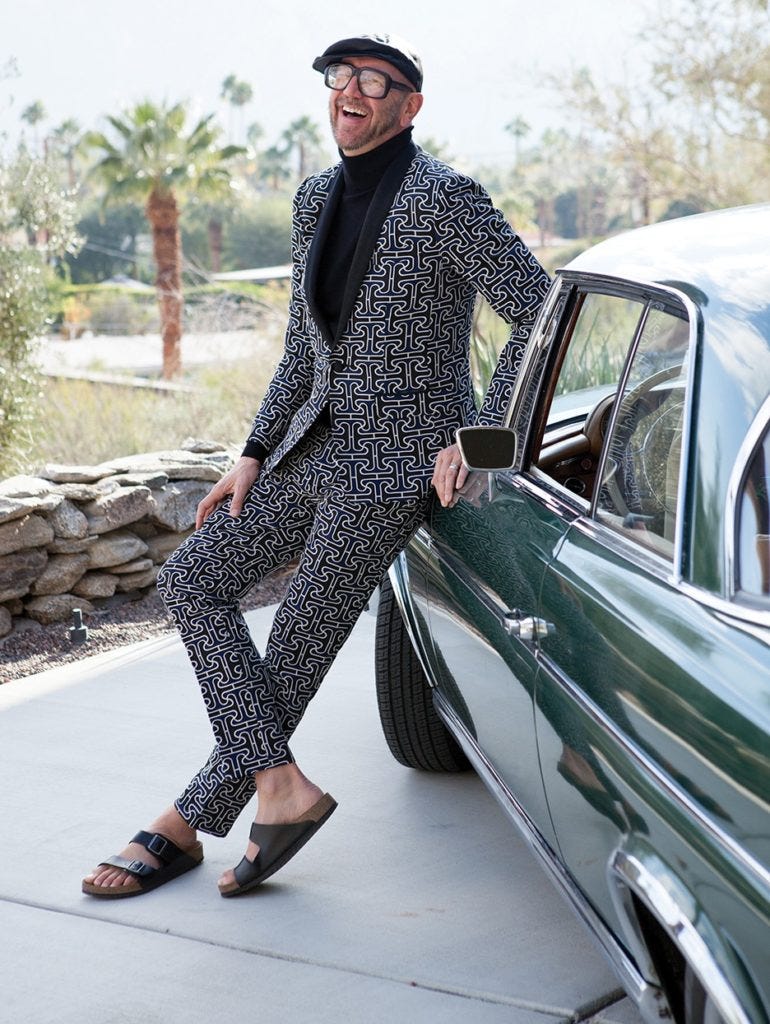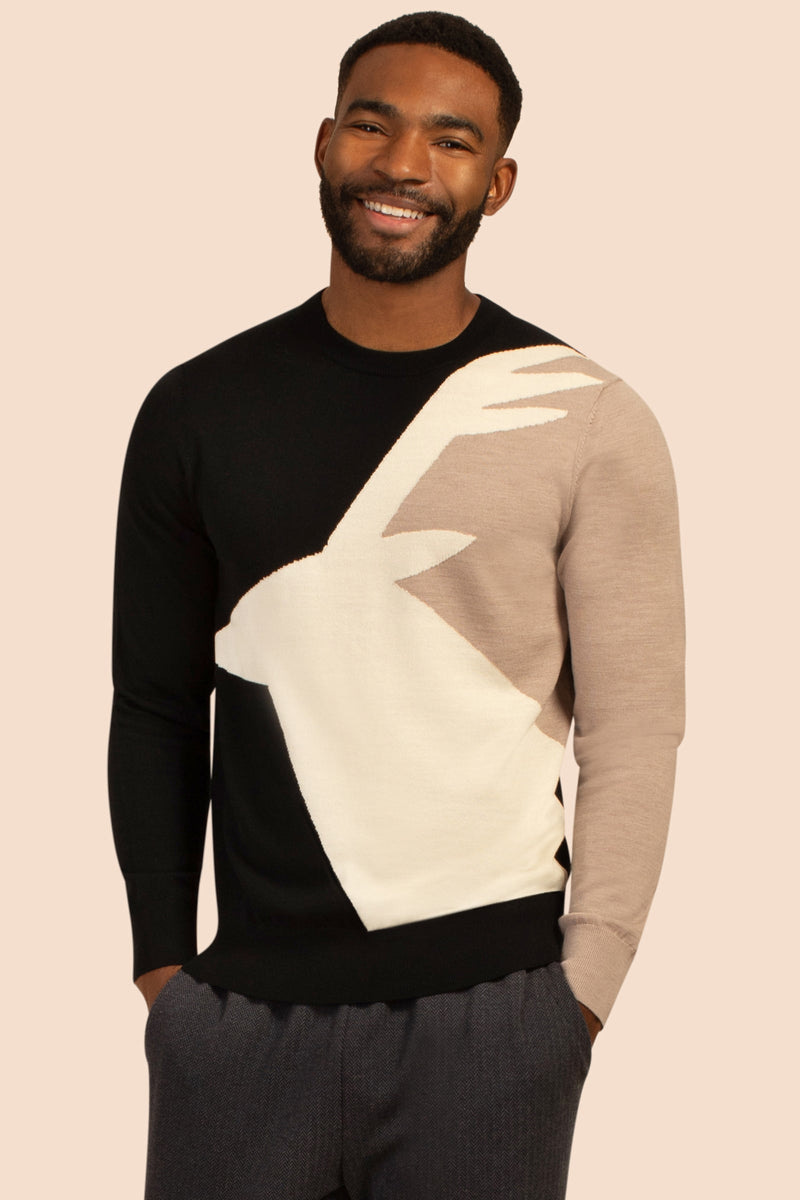Do people think your name is Mr. Turk?
Yes [laughs]. The name actually started as a joke. As Trina became more famous, people would assume I was Mr. Turk. And it would just crack us up.
Obituaries are necessarily for the living. A competent obituary will spend very little time on a person’s death and devote most of its coverage to the life lived. And a truly good obituary can have life changing power. Today is the 5th anniversary of the passing of a style icon and designer, Jonathan Skow, aka Mr. Turk.1 I never met him, so I want to limit this remembrance/exhortation to (i) what others have written about him and (ii) the impact his life and death had on me (primarily in the form of an obituary provided by his wife, fashion designer Trina Turk). I’m uneasy about editing the obituary in any way, so I’ve included it here in its entirety out of respect:
Jonathan D. Skow
December 22, 1962 — October 12, 2018
Jonathan Skow’s big, beautiful life ended on Friday, October 12, 2018 in Los Angeles with his family by his side. He was doing what he loved, bodysurfing in the ocean, when he suffered a devastating spinal cord injury on Labor Day in Hawaii. He dealt boldly and bravely with the severity of his injury. The accident was preceded by “an extraordinary life,” in his own words. He was 55.
The quintessential bon vivant, his generosity, infectious zest for life, boisterous laugh, wit and bold glasses were signature trademarks. The world loved his exuberance and positive outlook, as he lit up spirits and shared his joy abundantly. His friends galore adored him.
Jonathan was born to Harold and Barbara Skow in Seattle, WA, and his childhood was spent in Horizon View and on Lake Sammamish. At the University of Washington, he met his wife of 33 years and kindred spirit, Trina Turk, in a textile science class.
Jonathan and Trina migrated to Los Angeles in 1985 to pursue their stylish dreams. He was a fashion stylist for 12 years, then transitioned to freelance fashion and advertising photography. In 2008 he began to devote all of his time to their apparel company, Trina Turk. The dapper style of the Mr Turk menswear collection was created by Jonathan.
A true design visionary, in addition to photography and clothing design, Jonathan was also an open water swimmer, restorer of historic homes, architecture aficionado, amateur landscape designer, philanthropist, beekeeper, chef, and life-of-the-party, entertaining his entourages in Los Feliz and Palm Springs. His creativity and spirit were wild, free and spontaneous.
Jonathan has always loved the ocean and was an enthusiastic member of the West Hollywood Aquatics (WH2O) Masters swimming club.
Described by many as a powerful force of nature, his final exit was accompanied by an epic thunder and lightning storm over Los Angeles.
He is survived by his wife Trina, mother Barbara, brother Nathan (Luanne). He is preceded in death by his father Harold.
Jonathan’s simple advice: Have fun and enjoy your life. A Celebration of Life will take place at a future date. In lieu of flowers, memorial contributions can be made to LA Conservancy laconservancy.org; Palm Springs Modern Committee psmodcom.org; Palm Springs Art Museum Architecture and Design Center psmuseum.org; LACMA Decorative Arts and Design Acquisition Committee (DA2) lacma.org/DA2; the Trident Swim Foundation tridentswimfoundation.org; or ActBlue candidates secure.actblue.com.
Grief and responses to death are highly personal, so I take no offense at the idea someone can read the above and be unmoved by it. I was deeply affected by it the first time I read it (and more surprised to learn as I’m writing about it that this visceral response never quite wore off). This reaction was a mystery, at first. What about this resonated and was making me so emotional? You might have already spotted some of these aspects when reading it. A union having all the appearances of true love, resulting in a multi-decades marriage? An incredible list of hobbies and successes in multiple disciplines? Time and knowhow devoted to living the good life and sharing it with friends, colleagues and loved ones? Goddamn, you could so much worse with your one life! This obituary made me look at my own life up to that point and wonder what exactly I was doing with it. It was my own low/no stakes Caesar-Alexander parable. Five years later, I’m still taking care to ensure my life can’t be confused for a LinkedIn profile.
Before October, 2018, I was already a Trina Turk/Mr Turk customer, but that’s inadequate to explain the power of this obituary. I think “beekeeper” was what grabbed me initially. I remember wondering, who was this man that he had the luxury of developing that interest in addition to everything else going on? My interest was piqued by Skow’s hobby to the point I finally dipped one toe into beekeeping to see if it was for me at the end of 2022. As I suspected, it is not.
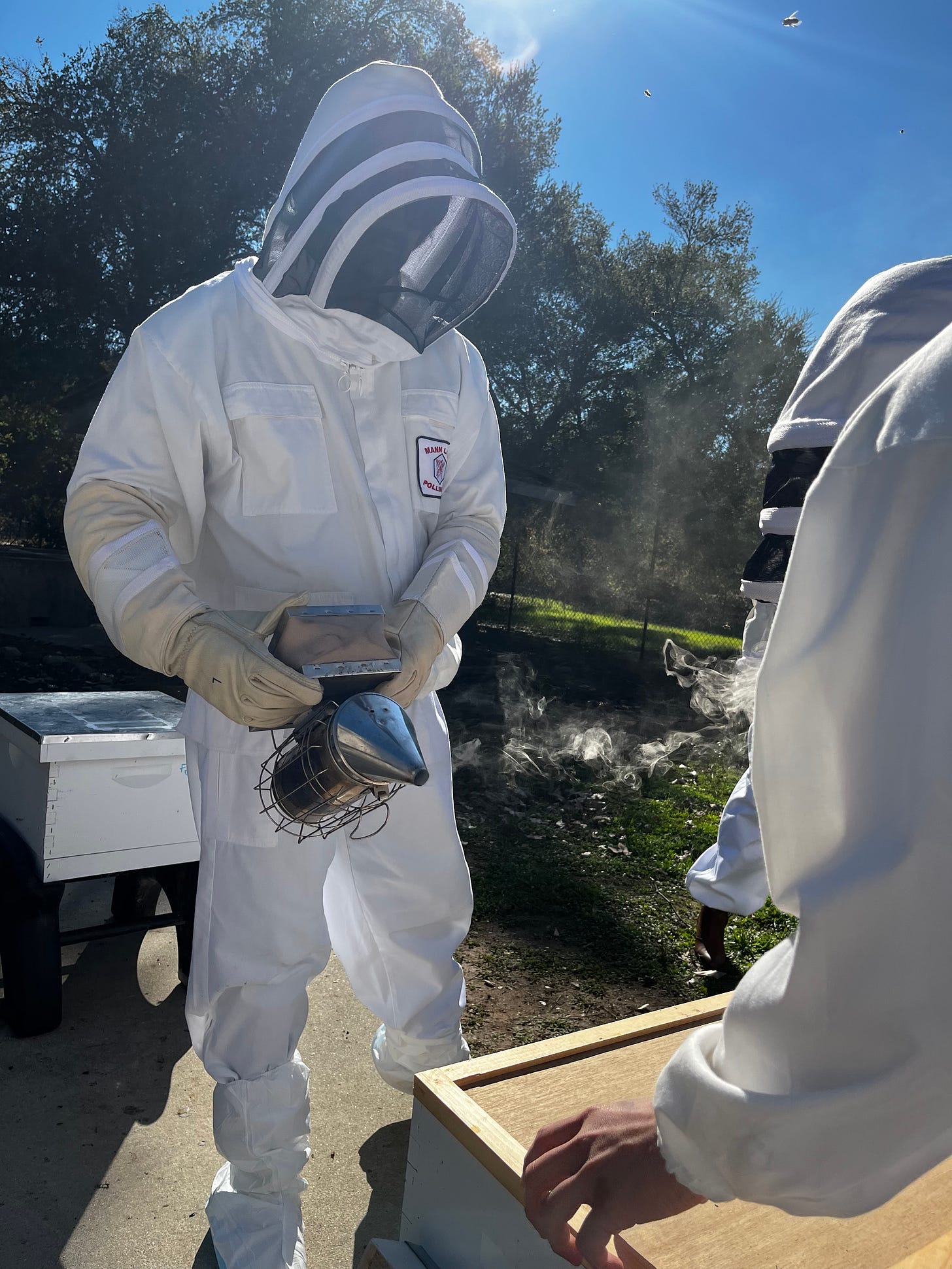
And then there’s his 1998 purchase and restoration with Trina Turk of the Ship of the Desert in Palm Springs. If Ralph Lauren has his ranch and other fantasy locations, this one seems to be Trina and Mr. Turk’s. Located above The Mesa neighborhood and built in the Streamline Moderne style, this home was seriously damaged by fire mid-renovation. The Turks then rebuilt the house in accordance with the original 1936 plans. This restoration effort is illustrative of a larger commitment to the history of the place, and seems to have won the couple considerable accolades among the preservationist set (with a plaque from the City of Palm Springs Historic Site Preservation Board outside the home to prove it).
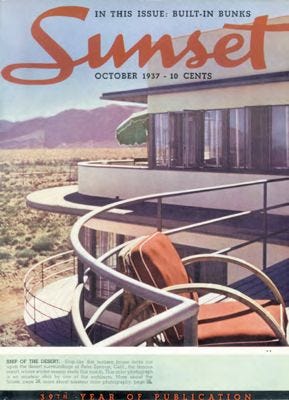

The impression of Skow I’m left with is that he was the author of his own life, in all the ways that usually matter to us. So let’s also get this part out of the way—I don’t think this characterization of Skow in the obituary is myth-making or just family lore. The consensus really seems to be that he was a lovely guy who had figured out how to live. For me, it’s enough that it looked like he was having a lot of fun—I can just engage with the legacy on that level.
He was described by The Hollywood Reporter as “impish” (which seems in accord with KCRW describing him as “extremely tall” and having a “saucy sense of humor”). As the West Coast Editor for Architectural Digest told KCRW in the same 2018 article on the subject of Skow:
I'm sure there will be many puns about his height. But Jonathan truly was a larger-than-life figure, and not just because of his divinely idiosyncratic personal style. He was full of warmth, humor, and generosity -- and those qualities were right on the surface. He radiated sweetness and joy.
So I’ve drawn some inspiration from this man about how I should try to live. His life is a powerful reminder that you can build and enjoy a life of your own design (allowing for sufficient privilege/luxury of course, but I’d argue a lot of us have more autonomy in this regard than it is fashionable to admit). The power of the obituary also draws on the fact that all this depth and complexity were hiding in plain sight for me and I was only able to notice and appreciate those aspects after the obituary. That old saw, you don’t know what you have until it’s gone.
Knowing more about the designers behind the clothes, I now believe the Trina Turk and Mr Turk brands are right up there with some of the more famous brands like RRL in terms of an end-to-end, focused vision. Like any great brand, they’ve invented a world I don’t want to leave. A Fast Company profile of Trina Turk in 2020 captures the intensity and consistency of the dual brand’s visions nicely:
Throughout her career, she has managed to define a distinct strain of American style, one that is disparate from the preppy aesthetic popularized by Ralph Lauren, Tommy Hilfiger, and Brooks Brothers, and from the Western look defined by hard-wearing Levi’s jeans and flannel shirts. Instead, Turk’s garments call to mind Mods and Hippies. They immediately transport you to a pool in California or a beach in Florida.
And this is the key to understanding the Turk brands. As Skow noted in an interview with KCRW:
“And what sells in Palm Springs is really specific,” he said, adding that buyers there typically choose apple green over navy. “Palm Springs is a very accepting place if you want to wear tangerine orange.”
The brand has an irreverence and joyfulness to it that can make it hard to wear if you aren’t in permanent vacation mode (or in a place where fashion deals in those tropes). In an interview in Palm Springs Life in May, 2014, the brand’s aesthetic is described as “an edgy Lilly Pulitzer for men.” Also completely accurate. Skow also revealed the origins of the brand’s name in the same feature:
How did Mr. Turk come to be?
It started when we opened a men’s store in Palm Springs in 2002. Back then, we were primarily using women’s fabrics that we thought would work for men and cutting them into men’s silhouettes.Do people think your name is Mr. Turk?
Yes [laughs]. The name actually started as a joke. As Trina became more famous, people would assume I was Mr. Turk. And it would just crack us up.Who is the Mr. Turk man?
There is not a specific guy — we have gay, straight, old, young. The Mr. Turk man is very social. I have clients who say, “Whenever I wear your clothes, I get so much attention.” The Mr. Turk man is someone who wants to be noticed for his clothes.
I’m also someone who could easily be happy being Mr. [my wife’s last name]. In fact, I am often addressed this way in error when flying in the nicer parts of airplanes, checking into hotels, etc.—she has all the status to have arranged these things, but people in these scenarios still assume her last name has been taken from me (it’s an easy mistake to make and I never correct anyone, it’s funnier that way and such is the assumed state of patriarchal earnings in this part of the 21st century). As for Mr. [wife’s last name], he is simultaneously my father-in-law and an affable, degenerate jetsetter who sometimes cries when the aesthetics are just right.
I don’t know that I wear Mr Turk to be conspicuous in the way Skow is suggesting above, but I can see that thinking at work behind many of the pieces. For example, the matching floral ensembles, the louder shirts and blazers you can wear with matching shorts or pants.
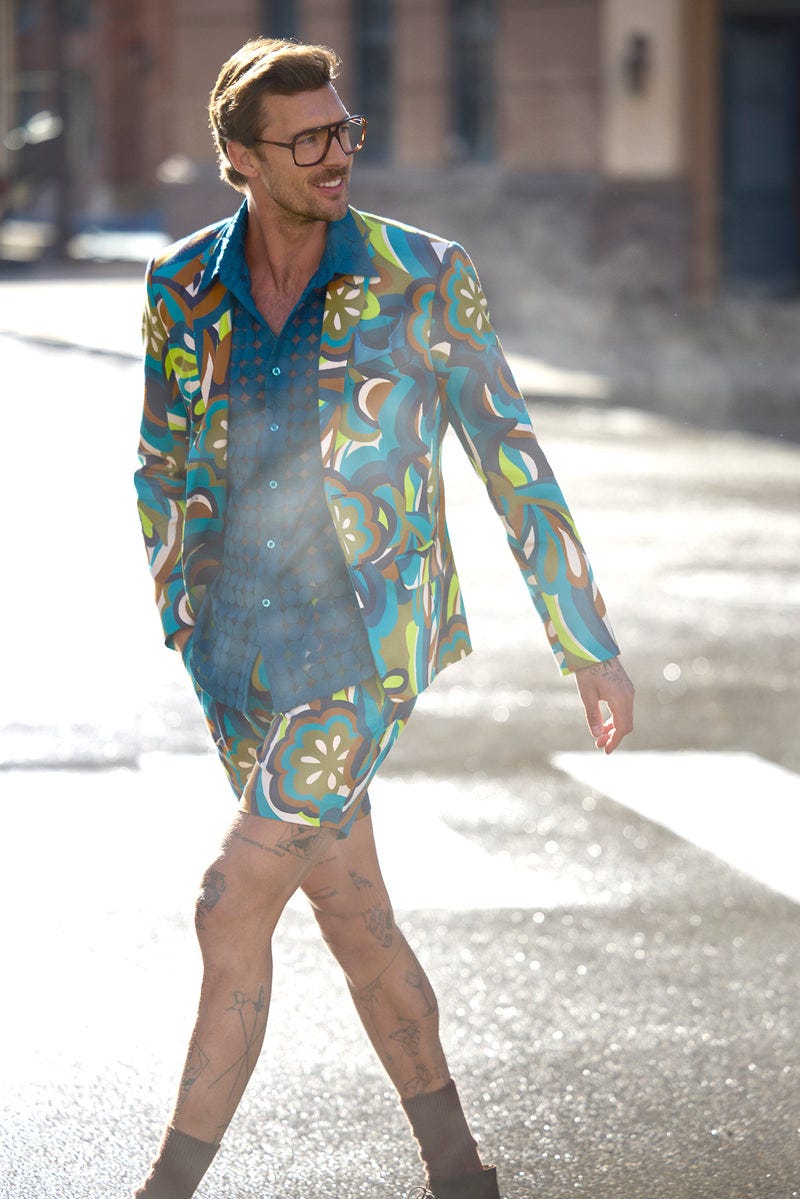
I think Trina’s take on bright patterns and fabrics probably encapsulates how/why the brand resonates with me:
“I’ve always been drawn to bright vintage prints because they represent optimism,” she says. “They make the statement that we control our own happiness. We can respond to the world around us with joy.”
The fun of Mr Turk is something totally lacking in a lot of traditional menswear. It’s usually just a Peaky Blinders fever dream—some guy on a British estate scowling at you while he hunts grouse. Jonathan Skow’s line is the spiritual opposite, a kind of freedom in counter culture. Designers can help men feel important, successful, powerful, rich, whatever—but what about wanting to feel fun? What about wanting to feel free? In addition to jumpsuits for men, the Mr Turk line has caftans. What’s a better embodiment of freedom, a more intoxicating entry point into a lifestyle, than a caftan (or a belted jumpsuit, dare I say speedsuit)?
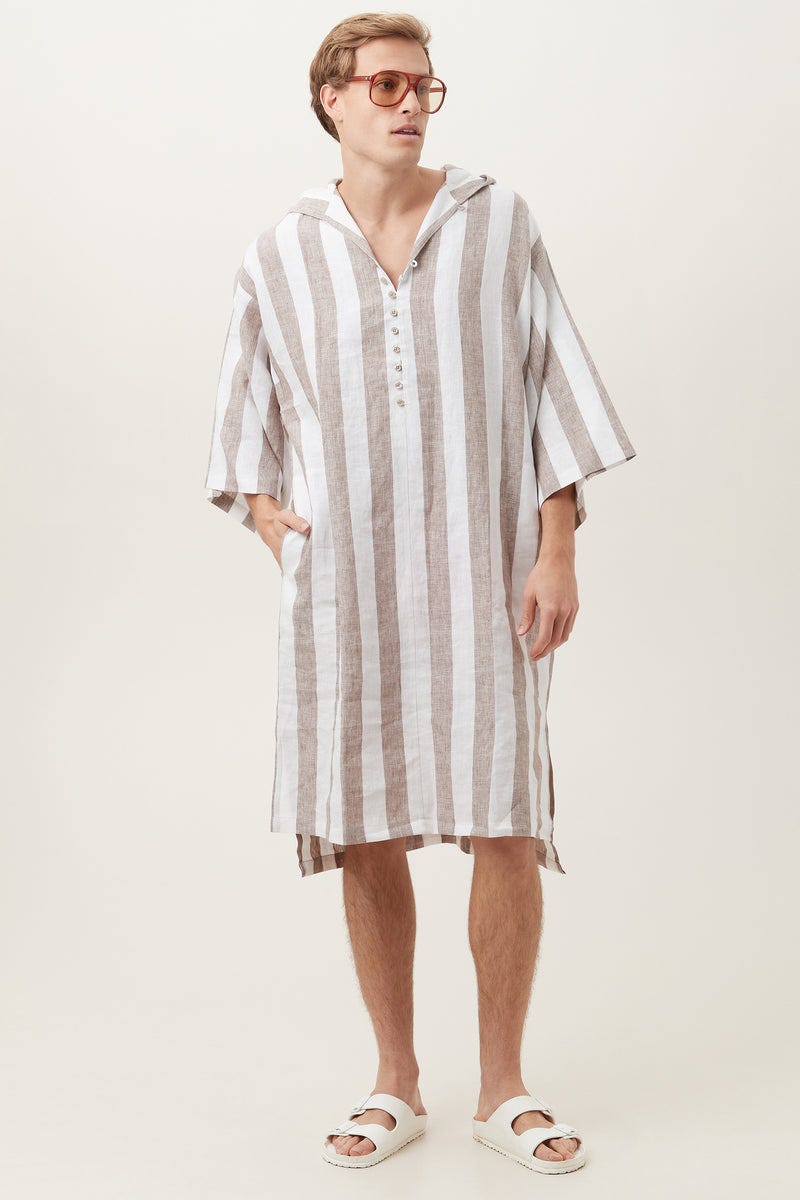

For my own part, I have a few pieces acquired from Mr Turk over the years: a men’s jumpsuit/shortall (if you prefer, a romp-him, yes they exist and they are great), a white cabana shirt in eyelet-style fabric, a fun aloha-adjacent psychedelic shirt (pictured at the top of the post), a pair of swim trunks, and a textured pair of shorts. We also have an ice bucket and a pair of great beach towels from the Trina Turk line (and my wife has quite a few pieces from the women’s line, but I couldn’t catalog them offhand).
For anyone looking to get into the line, I find their knitwear to be the most accessible, even if you’re not near a pool (sweater polos are very of the moment and a particular strength of theirs). The line can also be killer/sleeper pieces for aprés ski (which is very serious business) and holiday formal (some of the blazers are great for New Years Eve). I’ve included a picture below of a seasonal favorite (I don’t own it, but I’m always glad to see this design and I’d love to wear it to an ugly sweater party if the company had me in the mood for rejecting the premise).
So the real Mr. Turk is now history, but his “California Dapper” brand continues. He’s left behind the kind of richness I can only aspire to (and fall short of, but we’re all allowed to have goals). “Writing obituaries is an art,” according to Anne Wroe, on the subject of writing them for The Economist, “[i]t should be done in a way that, by the time the readers have finished reading, they wish they would have met the person.” While I never met Jonathan Skow, I certainly would have liked to. His work and philosophy live on in his customers and the pseudo-eponymous brand he shepherded into reality (and in a much smaller but more personal way, as the indirect catalyst for me to take my interests more seriously, including the continuing publication of this very unnecessary Substack, Sublime Prosaic).
Obituaries as a genre end up focusing on life much more than the death itself. In some ways, the dying isn’t just the saddest part, it’s also the least interesting. After all, we don’t have a lot of control here. We don’t choose if, or when we die, nor do we choose to be born. The harder part, the more interesting part, is all in the middle. So then, how do you intend to live?2
Potpourri:
Wherein I occasionally make good on my promise to the reader to repackage and re-contextualize some of the world’s endless content.
Happenings
The Adventurers’ Club of Los Angeles’ Night of High Adventure on 10/14/23, the “annual black-tie gala of fine dining, camaraderie, and amazing adventure stories” is sold out. Maybe next year…
If you want a break from house music, nice tip from my friend JManz (photographer and unfailing guide for all things cool) about the Lo Moon residency at Zebulon in Los Angeles (Mondays in October).
To Read/Watch
I preordered (and forgot about it until it showed up this week as a welcome surprise) the latest book from Bill Watterson (creator of the profoundly and enduringly good Calvin and Hobbes): The Mysteries. It’s a very short read, and I haven’t run across reviews yet, so I’m stuck with my own interpretation for now (the story ended as sort of comforting (?), in contrast to some very visceral and spooky artwork). Look forward to seeing what greater minds make of it, but we are probably the real monsters.
Have also been enjoying The Lost Supper by Taras Grescoe (recently available for me on the Libby app). A kind of travelogue examining foods of antiquity and what they might offer for our future. Some proper bashing of the “agriculture was a mistake” crowd in the opening chapter, including Jared Diamond (Guns, Germs and Steel) and Yuval Noah Harari (Sapiens).
Speaking of bashing Sapiens, I’m liking this Financial Times writer, Janan Ganesh more and more. Lord, deliver us from Babbittry.
Ken Burns has a new documentary about the American Bison premiering on PBS next week, 10/16/23. Outside magazine3 has a nice profile of the filmmaker, the film’s subject and his process (his total dedication to his subjects inspires: he spent 30 years thinking about buffalo before finally setting out to make the film).
We’re out here scanning stuff. Here’s what trilobites were eating 465 million years ago. We also might gain the ability to read the contents of carbonized scrolls thanks to advances in machine learning and scanning. The Vesuvius Prize has cash for someone who can electronically unroll and read the charred remnants of papyrus scrolls from a Herculaneum library. Here’s a fascinating look at the University of Kentucky’s efforts on the problem:
I’m a few months late to the Chartreuse crisis, which is making my forthcoming installment of On Drinking about the Nuclear Daquiri more difficult. Jason Wilson of Everyday Drinking has a nice examination of the issue, which I’ve linked below. In the meantime, there are also guides out there about picking a Chartreuse substitute, but I’m finding the substitutes equally hard to find or out of stock. For now, I have some Génépy on hand.
One last note on obituaries. Was thankful to discover and watch Obit, a 2016 documentary by Vanessa Gould following the obituary writers at the New York Times. It helped tremendously with my paranoia around some of the ettiquette in writing about Jonathan Skow (or publishing on the anniversary of his death). I’m still not sure I’ve gotten all of that quite right, but here’s the trailer:
The brand name seems to playfully omit the punctuation after “Mr” but I’m including it here when referring to the man behind the clothes.
I originally wanted to go with a solipsistic inversion here: “dying is easy, living is hard.” I was quite enamored with this sentiment, but became quickly suspicious that someone wiser/more famous has probably said this before. To my disappointment, it’s a line from Hamilton, which I have not seen, but is notably another subject of Janan Ganan’s crusade against normies, linked above.
Publishing Sublime Prosaic has caused me to stumble upon many wonderful and niche magazines, including Outside, Field & Stream, Grazia, Keys Weekly, Southern Living, Got Rum? and Garden and Gun.




